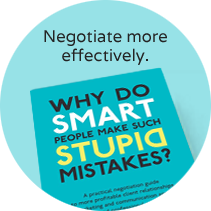Insights

How to decide which clients to pursue & which to avoid!
Not all clients are worth winning. Some have “trouble” written all over them from Day 1. Knowing which prospective clients to walk away from is as important as knowing which clients to pursue.
Chris Merrington, author of “Why do smart people make such stupid mistakes?” shares his thoughts on choosing which clients to reject (and give to your competitors) and which to invest in.
Optimism, (ie thinking ‘let’s go for it’ anyway) is great but can sometimes lead us to pursue the wrong opportunities when in reality we don’t really stand a chance of winning the business. Winning new clients is expensive in terms of our time, effort and emotion. Decide at an early stage which opportunities to say ‘no’ to and which to say ‘yes’ to. Decide your ‘go/no go’ as quickly as possible. The more time and effort you invest into a prospect the harder it is to subsequently walk away from an opportunity.
Decide what your criteria are for choosing whether to invest time and effort into pitching for prospective clients or not. See new clients as investments. Invest more into those with the best potential and likely decent ROI.
So how do you decide which clients or projects to accept or reject? Firstly it must be, and is, your choice, your choice. Decide in a business-like way, not from a feeling of obligation or guilt. Your clients make commercial decisions. Why should it be any different for you?
Develop a list of criteria in order to decide whether to pursue an opportunity or decline. Here are a few suggestions:
- Is this opportunity in your core competency area? Does it play to our “sweet-spot”?
- Is the budget, timescale or workload realistic and acceptable? Will it be profitable?
- Is the prospect’s requirement or brief realistic? Is it written? (A friend of mine says “a verbal brief isn’t worth the paper it’s not written on”)
- Do you suspect it is a “done deal” with another company and you are simply providing a comparative price? Do they have no intention of moving from their incumbent supplier?
- Does the relationship feel right? Do they want a real business relationship or simply a price?
- Do your instincts suggest this client will be trouble? If a client is troublesome in the early days this is often a sign of things to come. Things are unlikely to improve. Trouble in the early days normally means more trouble later.
- What is the bigger opportunity with this client? What’s the long term potential?
- How much do you need the business? (This is the dangerous one! If we are desperate it is easy to make poor decisions under pressure which long term we are likely to regret. Beware of chasing turnover to meet payroll. This stacks up problems for the future. Beware of setting precedents you come to regret in the future.)
- Your mind-set is important. If you pitch for new clients in a desperate mindset you are more likely to compromise your fees and prices and simply create problems for the future.
This is not an exhaustive list by any means. There may be some criteria which are “must haves” and others which are “like to haves”. You may also decide to weight certain criteria more heavily than others.
The benefit of having a criteria list is that it avoids making decisions solely based on gut feel and intuition. This gives the ability to make objective decisions which also helps to rationalise decisions with colleagues and bosses especially if they were involved in creating the criteria list in the first place.
So let’s win clients we want and projects we want, at prices which are both credible and profitable and to timescales which are achievable.
Turning away work is a great boost to your self-belief and confidence.
no comments
